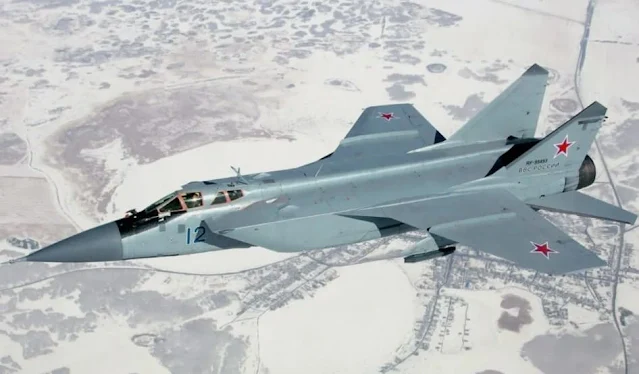Not many fighter jets are capable of operating at stratospheric altitudes, and one that is capable of flying above 10,000 meters is the Russian Air Force's MiG-31K Foxhound. As recently reported, the MiG-31K was deployed to fly into low Earth orbit for a mission to intercept enemy aircraft in border areas.
In response to several NATO fighter aircraft which recently flew to Russia's northern borders, MiG-31Ks from the Northern Fleet actively participated in a stratospheric combat simulation in the Bering Sea.
The Russian Ministry of Defense, through an official communiqué, revealed, “The crew of a MiG-31K fighter jet from a separate collective aviation regiment of the Northern Fleet was involved in a simulated air battle in the stratosphere.”
In the simulation, a so-called enemy aircraft has approached the Russian border. The Defense Ministry clarified that the Northern Fleet's MiG-31K fighter jets were sent to identify intruders and prevent violations of Russian airspace.
Russian MiG-31s flew nearly 11,000 meters above the Bering Sea in an aerial exercise. The jet releases missile missiles and eliminates the simulated threat. The timing of this exercise is noteworthy, as it comes close to recent events when Russia was forced to deploy MiG-31K Foxhound jets, to prevent US Navy P-8A Poseidon maritime reconnaissance aircraft from violating Russian territory in the Norwegian Sea.
After the Ukraine conflict, Western military aircraft consistently patrolled the airspace near the Russian border, resulting in frequent encounters with Russian fighter jets. This increased air activity threatens regional stability due to the potential for misunderstandings leading to unexpected escalation amidst pre-existing tensions.
The Ukraine conflict has increased tensions between the West and Moscow, creating alarm along the Norwegian-Russian border. NATO, with support from Finland and Sweden, is asserting its influence in this area against Russia's wishes.
The Ministry of Defense stated that during the Finval-2023 exercise, MiG-31K jets simulated the interception of enemy cruise missiles in the Chukchi Sea.
The involvement of MiG-31s in combat at stratospheric altitudes is not an unprecedented event. In 2019, MiG-31BM fighter pilots conducted their first upper-atmospheric combat over the Kamchatka Peninsula in the Russian Far East, simulating an interception against practice airspace attacks during training, with similar exercises in 2020.
In September, the Russian Navy's Baltic Fleet reported that its MiG-31 jets were practicing stratospheric missile attacks. “MiG-31 pilots performed flight maneuvers in the stratosphere, honed skills in evading enemy aircraft attacks and moved to operational airfields in the region.”
The Russian MiG-31 is claimed to be effective against rival aircraft and cruise missiles due to its superior speed and range. This twin engine fighter jet is capable of reaching a top speed of Mach 2.83, which makes this aircraft one of the fastest in the world.
The effectiveness of the MiG-31 is enhanced by the N007 Zaslon phased array radar system. This sophisticated radar can detect multiple targets up to a distance of 200 kilometers. This allows the aircraft to identify and intercept enemy aircraft and cruise missiles from long distances.
The MiG-31 is equipped with long-range air-to-air missiles such as the R-33 and R-37, which are capable of hitting targets up to 300 kilometers away. These missiles are designed to attack and destroy enemy aircraft and cruise missiles from long distances, providing an advantage in air combat.
The MiG-31K's robust structure and powerful engines enable operations at high altitudes and in adverse weather. This makes it a powerful interceptor, patrolling efficiently and defending a wide airspace. Its capacity to maintain high speeds and altitudes over long periods of time increases its effectiveness against enemy threats.
The MiG-31 not only has powerful attack features, but also an advanced electronic warfare system. This can disrupt and mislead enemy radar and missile tracking systems, increasing chances of survival and complicating targeting by enemy aircraft or cruise missiles.
The MiG-31 Foxhound has set several world records. This fighter jet had reached an absolute maximum altitude of 37,650 meters in 1977, and set a record time to 35,000 meters of 4 minutes, 11.78 seconds, both set by the famous MiG test pilot Alexander Fedotov.
For your information, the stratosphere is one of the layers of the Earth's atmosphere which is located above the troposphere, the lowest atmospheric layer. The height range of the stratosphere typically begins at a height of about 10 to 15 kilometers above the Earth's surface and continues to about 50 kilometers (about 31 miles) above the Earth's surface.



